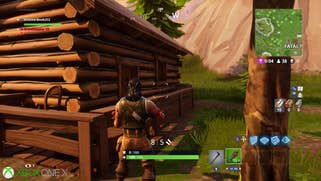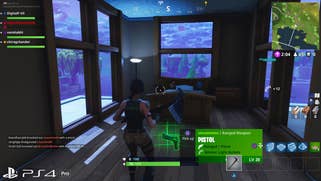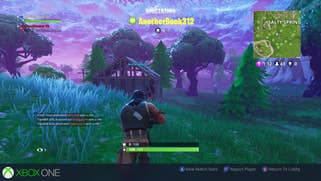Fortnite's new 60fps mode is the real deal
Buttery-smooth frame-rates on all consoles.
Propelled towards mass popularity by virtue of its superb Battle Royale refresh, Epic Games' Fortnite has recently been enhanced still further with the inclusion of an optional 60 frames per second mode - a potential game-changer for a fast-paced shooter like this. Now, we've seen a range of 'performance' modes in the past that target 60fps on Sony and Microsoft's enhanced consoles, but generally, they fail to deliver. The good news here is that Epic's work is the real deal - and it's by no means exclusive to the more powerful consoles, with owners of the standard models getting an equally impressive boost.
Based on information gleaned from social media and patch notes, the developer's approach in delivering this impressive buttery-smooth experience involves a combination of new Unreal Engine 4 graphics technologies paired with some intensive CPU optimisation. The results pay off as looking at frame-rates across both base and premium consoles, the new mode locks at its 60fps target for the vast majority of the duration. Consistency is generally excellent, holding up well throughout both traversal and intense gunplay, with all platforms running smoothly with the minimum of hitching.
It's not quite perfect though - moving into the more graphically complex towns can see some minor drops and a little tearing at the very top of the screen, but beyond that, the impact on gameplay is limited to brief moments of stutter that quickly pass. Fortnite at full frame-rate also passes muster as a premium experience on all consoles too - 60fps is 60fps, after all - although small dips in performance occur a little more often on the base Xbox One across a general run of play. It's only a subtle difference though, and we'd still take the new mode over the older 30fps standard.
Of course, the move from 30fps to 60fps just looks a lot smoother, but the new mode offers a crucial advantage over Fortnite's main Battle Royale console rival - the Xbox One version of PUBG. Bluehole's early access title struggles to maintain its 30fps target and certain conditions in particular can contribute to some particularly poor moments. And in this sense, there are one or two similarities in how Fortnite's frame-rate is affected and more specifically, what scenarios can cause performance problems.
For example, PUBG's most noticeable frame-rate weakness kicks in when parachuting into the level - and the same process also causes issues in Fortnite. The increased draw distances and environment complexity are possible culprits here, with prolonged, harder stutter perhaps indicating online-based bottlenecks too. This is perhaps to be expected owing to the sheer volume of players in a fairly localised area in these early stages but thankfully, these issues clear up once we hit terra firma, with performance quickly stabilising nicely.
Compromises? Sure, they're there if you look for them. In reducing per-frame render time to 1/60th of a second - 16.7ms - dynamic resolution scaling along with temporal reconstruction plays a key role in accelerating the render pipeline, and this can introduce a combination of softness and some dithering artefacts, with the extent changing on a per-platform basis. However, the balance between image quality and performance is well judged for the most part, allowing players to get a smooth, stable experience during moments where a fixed resolution would cause frame-rates to drop.








In addition to the introduction of a dynamic framebuffer, a few visual tweaks also help to reduce the rendering load, with reduced shadow quality present across all consoles when running at with 60fps engaged when compared to the older half-refresh mode. Motion blur is also removed on PS4, Xbox One and Xbox One X. However, curiously, this is definitely not the case on PS4 Pro, which retains the effect across all modes in the game.
So just how dynamic is that scaler and to what extent does image quality shift across the run of play? The standard Xbox One has the weakest GPU of all the current-gen consoles, peaking at 900p resolution and dropping to something closer to 600p in more demanding scenes. In terms of the most common resolution we saw, 792p seems fairly prolific. The increased frame-rate is still our preferred way to play Fortnite, but it's here where the trades kick in hardest.
By contrast, the Xbox One X is the most powerful console of the bunch and it delivers some really impressive results. Our lowest recorded resolution comes in at 1152p, rising to 1728p at peak, with 1440p the most common measurement we found. The contrast between the base and enhanced consoles is quite remarkable - Xbox One X works nicely on a 4K screen despite its shifting sub-native pixel count, but the lower resolutions on the base model leads to a very soft looking game.
Both PS4 and Pro aim for native 1080p with the enhanced model using the extra GPU power to layer in additional effects, including enhanced draw distances. In complex areas, resolution on PS4 falls to around 756p at its lowest, with Pro coming in at around 900p or just below. However, with that said, pixel counts are generally higher across the run of play, with PS4 regularly hitting 900p, and Pro achieving 1080p.












Players are essentially given a good range of options here: improved image quality on the standard 30fps mode, but a genuinely impressive full-refresh alternative delivered by the new patch. However, one thing to stress is that 60fps is essentially exclusive to the Battle Royale game mode, not the Save the World option that Fortnite originally launched with.
There are both negative and positive changes in this tower defence-style mode. There's a new option that allows you to unlock the frame-rate, with Epic being careful not to promise 60fps in the description. That's probably for the best, with the game handing in a somewhat wobbly 30-40fps when we tested it on Xbox One X. As expected, it's better simply to cap at 30fps, which provides a more stable, consistent experience. The dynamic scaling technology is present and correct though, and that's great news as it eliminates most of the jarring performance drops under 30fps we saw when we first tested the X-enhanced patch. The revised code on Microsoft's new console isn't quite as stable as the 1080p Pro alternative, but it's a big, big improvement.
But it's the Battle Royale mode that's the star of the show. This part of Fortnite really has been transformed into a fully viable 60 frames per second experience - not just on the enhanced consoles but on all of them. It's exceptionally impressive stuff in motion. What you lose in pristine image clarity you gain in improved, smoother gameplay - and we're pretty confident in saying that once you've played the game at 60fps, you won't be going back to the older mode any time soon.








